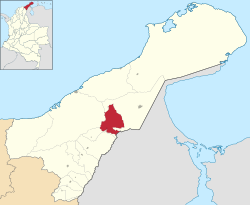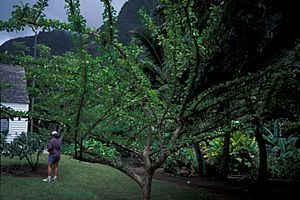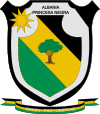Albania, La Guajira facts for kids
Quick facts for kids
Albania, La Guajira
|
|||
|---|---|---|---|
|
town
|
|||
|
|||
| Nickname(s):
"Princesa Negra"
(Black Princess) |
|||

Location of the town and municipality of Albania in the Department of La Guajira.
|
|||
| Country | Colombia | ||
| Region | Caribbean | ||
| Department | La Guajira | ||
| Foundation | January 27, 1801 | ||
| Area | |||
| • Total | 425 km2 (164 sq mi) | ||
| Elevation | 320 m (1,050 ft) | ||
| Population
(Census 2018)
|
|||
| • Total | 26,940 | ||
| • Density | 63.39/km2 (164.17/sq mi) | ||
| Time zone | UTC-5 | ||
| Climate | Aw | ||
| Website | albania-laguajira.gov.co/ |
||
| * | |||
Albania is a town and municipality in the La Guajira Department of Colombia. It was once known as Calabacito, which means "Small Calabash tree" in Spanish.
Albania is one of the newest municipalities in the La Guajira Department. It was officially created on March 19, 2000. Close by, there is a special camp called Mushaisa. This camp is just for the workers and families of the Cerrejón coal mine.
Geography of Albania
The municipality of Albania is located in the Guajira Peninsula. This is in the northern part of Colombia. The land here is mostly flat and dry. It is near the Serranía del Perijá mountains to the east. The Sierra Nevada de Santa Marta mountains are to the west. The Ranchería River flows through this area.
Albania shares its northern border with the municipality of Maicao. To the east, it borders Venezuela and Maicao. To the south, it borders Hatonuevo. To the west, it borders Hatonuevo and Riohacha.
The main town of Albania is located at 72° 56’ east and 98° 08’ north. The total area of the municipality is 425 square kilometers. Since 2001, a special area of about 95 square kilometers has been set aside. This area is for mining and connects Albania with the town of Cuestecitas. Albania has one of the largest coal deposits in all of Colombia.
History of Albania

The village of Calabacito was founded a long time ago, in the early 1800s. The first people to live here were indigenous people. These groups included the Cocinas, Cariachiles, and Wayuu. They were nomads, meaning they moved around a lot. Because of this, they eventually left the area.
Later, the area was settled again. These new settlers were former African slaves or their descendants. They likely came from places like Moreno, Tabaco, or Barrancas, La Guajira. They might have been escaping difficult situations. Some also came from a settlement called "Soldado" around 1903. They were trying to escape political problems or a civil war. This war was known as the "Thousand Days' War" (1899-1902).
The first settlers wanted to start farming. The area had many Crescentia cujete trees. These trees are also known as Calabazos or Totumos. This is how the village got its first name, Calabacito.
For a long time, Albania was part of the Province of Santa Marta. This changed in 1911. It then became part of the Special Commissary of La Guajira. The name Calabacito was changed to Albania in 1937. One story says it was named after the daughter of a local leader, Alba Londoño Sánchez. Another story says it was named after the country Albania in Europe.
During the time of Gen. Gustavo Rojas Pinilla, Albania became officially part of the Special Commissary of La Guajira. This happened in 1954. It was grouped with Uribia, La Guajira (which was the capital then) and Maicao. The villages of Cuestecitas and Manantial were also included.
In 1960, the government created the National Intendency of La Guajira. This made La Guajira a department in 1965. Albania officially became its own municipality on March 27, 2000. This was decided by the Department Assembly of La Guajira. The first Mayor of Albania was Adel Enrique Pinto.
Climate
| Climate data for Albania (Camp Intercor), elevation 122 m (400 ft), (1981–2010) | |||||||||||||
|---|---|---|---|---|---|---|---|---|---|---|---|---|---|
| Month | Jan | Feb | Mar | Apr | May | Jun | Jul | Aug | Sep | Oct | Nov | Dec | Year |
| Mean daily maximum °C (°F) | 32.6 (90.7) |
33.4 (92.1) |
34.4 (93.9) |
34.4 (93.9) |
34.3 (93.7) |
34.3 (93.7) |
34.9 (94.8) |
35.4 (95.7) |
34.5 (94.1) |
33.1 (91.6) |
32.5 (90.5) |
31.8 (89.2) |
33.9 (93.0) |
| Daily mean °C (°F) | 27.1 (80.8) |
27.5 (81.5) |
28.1 (82.6) |
28.5 (83.3) |
28.3 (82.9) |
28.6 (83.5) |
29.1 (84.4) |
29.0 (84.2) |
28.2 (82.8) |
27.4 (81.3) |
27.2 (81.0) |
26.7 (80.1) |
28.0 (82.4) |
| Mean daily minimum °C (°F) | 22.0 (71.6) |
22.6 (72.7) |
23.1 (73.6) |
23.6 (74.5) |
23.5 (74.3) |
23.8 (74.8) |
23.9 (75.0) |
23.4 (74.1) |
22.3 (72.1) |
21.8 (71.2) |
22.1 (71.8) |
21.9 (71.4) |
22.9 (73.2) |
| Average precipitation mm (inches) | 14.7 (0.58) |
15.7 (0.62) |
3.2 (0.13) |
95.7 (3.77) |
135.4 (5.33) |
75.5 (2.97) |
53.2 (2.09) |
93.0 (3.66) |
158.3 (6.23) |
177.7 (7.00) |
161.5 (6.36) |
54.0 (2.13) |
1,004.9 (39.56) |
| Average precipitation days | 4 | 3 | 2 | 7 | 11 | 8 | 7 | 9 | 13 | 15 | 12 | 7 | 92 |
| Average relative humidity (%) | 71 | 69 | 66 | 69 | 74 | 73 | 69 | 70 | 75 | 79 | 79 | 75 | 72 |
| Mean monthly sunshine hours | 260.4 | 223.0 | 232.5 | 174.0 | 189.1 | 201.0 | 244.9 | 241.8 | 219.0 | 189.1 | 225.0 | 226.3 | 2,626.1 |
| Mean daily sunshine hours | 8.4 | 7.9 | 7.5 | 5.8 | 6.1 | 6.7 | 7.9 | 7.8 | 7.3 | 6.1 | 7.5 | 7.3 | 7.2 |
| Source: Instituto de Hidrologia Meteorologia y Estudios Ambientales | |||||||||||||
People of Albania
In 2001, about 8,637 people lived in Albania. About 3,535 of them lived in the main town. There were 707 homes and about 807 families. This area is a traditional home for the Wayuu indigenous tribe.
A census in 2005 showed how people lived. Most people (67%) lived in houses. Some (19%) lived in apartments. A smaller number (13%) lived in a studio or rented room. About 6.1% of families had a home-based business.
Many homes in Albania have important services. About 72% had electricity. About 43% had sewer services. Most (66%) had clean water from an aqueduct. About 27% had natural gas. And 24% had a home telephone.
The population of Albania is quite young. About 51% are male and 49% are female. Many people identify with different groups. About 29% consider themselves indigenous. About 10% are mestizo, raizal, or Afro-Colombian.
Education
Colegio Albania is an American international school. It is located in Albania. You can find it within the Mushaisa residential complex.
See also
 In Spanish: Albania (La Guajira) para niños
In Spanish: Albania (La Guajira) para niños



